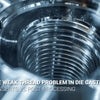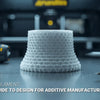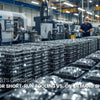How Can Advanced High Speed CNC Milling Maximize Your Manufacturing Efficiency?

How Can Advanced High Speed CNC Milling Maximize Your Manufacturing Efficiency?

In today's competitive manufacturing landscape, optimizing production efficiency while maintaining exceptional quality has become more crucial than ever. High-speed CNC milling represents a significant advancement in machining technology, offering manufacturers the ability to achieve unprecedented levels of precision and productivity.
High-speed CNC milling can increase productivity by up to 60% compared to conventional methods while delivering superior surface finishes and tighter tolerances. This advanced machining process is particularly valuable for complex parts requiring high precision.
Whether you're considering upgrading your manufacturing capabilities or seeking to optimize existing processes, understanding the intricacies of high-speed CNC milling is essential for making informed decisions about your production strategy.
[Table of Contents]
- What Exactly Makes High Speed CNC Milling Different From Traditional Methods?
- Which Critical Machine Components Enable Peak Performance?
- How Do Feed Rates and Cutting Parameters Impact Part Quality?
- Why Do Material Properties Matter in High Speed Milling?
- When Should You Choose High Speed vs Conventional Milling?
- What Are The Industry-Specific Implementation Challenges?
What Exactly Makes High Speed CNC Milling Different From Traditional Methods?
High-speed CNC milling distinguishes itself through advanced spindle technology and sophisticated control systems. At Hotean's custom CNC milling services, our expertise in high-speed machining demonstrates how modern technology transforms traditional manufacturing processes.
Traditional milling typically operates at speeds between 2,000 to 8,000 RPM, while high-speed milling pushes beyond 15,000 RPM, often reaching up to 30,000 RPM or higher. This fundamental difference creates distinct machining characteristics:
Speed and Feed Characteristics:
- Traditional Milling: Deeper cuts (0.125" to 0.5") at lower speeds
- High-Speed Milling: Shallower cuts (0.02" to 0.1") at significantly higher speeds
Heat Management:
- Traditional: Heat buildup in both tool and workpiece
- High-Speed: 75% of heat removed with chips due to higher velocities
Tool Engagement:
- Traditional: Higher tool engagement angle (90-120 degrees)
- High-Speed: Reduced tool engagement angle (10-30 degrees)
The physics behind high-speed milling reveals why it's so effective. When operating at optimal high speeds, the chips carry away most of the heat generated during cutting, preventing thermal damage to both the workpiece and the tool. This results in:
- Surface speeds exceeding 1,000 surface feet per minute (SFM)
- Chip loads ranging from 0.001" to 0.004" per tooth
- Reduced cutting forces due to higher spindle speeds
- Better dimensional accuracy due to reduced thermal distortion
Which Critical Machine Components Enable Peak Performance?
At the heart of any high-speed CNC milling operation lies a collection of precisely engineered components. Our industrial machinery expertise has shown that several key elements are crucial for achieving optimal performance.
Spindle Technology:
- Hybrid ceramic bearings rated for 20,000+ RPM
- Integral motor design for reduced vibration
- Advanced thermal management systems
- Built-in sensors for real-time monitoring
- Maximum speed capabilities of 40,000+ RPM
Control Systems:
- Look-ahead capability (500+ blocks)
- Real-time feed and speed optimization
- Dynamic acceleration control
- Tool path smoothing algorithms
- Advanced error compensation
Machine Structure:
- Polymer concrete bases for vibration dampening
- Linear guides with preloaded ball screws
- Temperature-controlled structural components
- Advanced coolant delivery systems
- Rigid mounting systems for extreme stability
How Do Feed Rates and Cutting Parameters Impact Part Quality?
Through our comprehensive CNC machining services, we've developed sophisticated parameter optimization strategies. The relationship between cutting parameters and part quality is complex and interconnected.
Critical Parameter Relationships:
Surface Speed (SFM):
- Aluminum: 1,000-5,000 SFM
- Steel: 300-1,000 SFM
- Titanium: 150-400 SFM
Chip Load Per Tooth:
- Roughing: 0.002"-0.004"
- Finishing: 0.0005"-0.001"
- Effect on tool life and surface finish
Depth of Cut:
- Axial depth: 10-30% of tool diameter
- Radial depth: 5-15% of tool diameter
- Impact on cutting forces and stability
Tool Path Optimization:
- Trochoidal toolpaths for high-speed applications
- Dynamic feed rate adjustment
- Automatic corner slowdown
- Tool engagement angle control
Why Do Material Properties Matter in High Speed Milling?
Material characteristics significantly influence the success of high-speed milling operations. Different materials exhibit unique behaviors at high cutting speeds, affecting both machining strategy and tool selection.
Common materials and their characteristics:
- Aluminum alloys: Excellent for high-speed machining
- Steel: Requires specific cutting strategies
- Titanium: Demands specialized tooling and parameters
- Composites: Needs careful consideration of fiber orientation
Understanding these properties allows for optimized cutting strategies that maximize efficiency while maintaining part quality.
When Should You Choose High Speed vs Conventional Milling?
Decision Matrix Based on Key Factors:
Part Complexity:
- Simple Geometry: Conventional milling often sufficient
- Complex 3D Surfaces: High-speed milling preferred
- Thin Walls (<0.020"): High-speed essential
- Deep Pockets: Combination approach recommended
Production Volume:
- Low Volume (<100 parts): Either method viable
- Medium Volume (100-1000): High-speed typically more cost-effective
- High Volume (>1000): High-speed almost always preferred
Material Considerations:
- Soft Materials (Aluminum): Ideal for high-speed
- Hard Materials (>45 HRC): Requires specialized high-speed techniques
- Exotic Alloys: Material-specific optimization needed
Cost Analysis:
- Initial Investment: High-speed 30-50% more expensive
- Operating Costs: 20-40% lower with high-speed
- Tool Costs: Variable based on application
- Energy Consumption: Generally lower with high-speed
What Are The Industry-Specific Implementation Challenges?
Aerospace Industry:
- AS9100 certification requirements
- Material traceability demands
- Complex geometry verification
- Tight tolerance requirements (±0.0005")
- Special process documentation
Medical Manufacturing:
- FDA compliance requirements
- Biocompatible material constraints
- Clean room manufacturing needs
- Surface finish requirements (Ra 16 or better)
- Complex validation processes
Automotive Sector:
- High-volume production demands
- Quick changeover requirements
- Cost-per-part pressure
- Automated quality control needs
- Just-in-time delivery requirements
Electronics Industry:
- Miniaturization challenges
- High-precision requirements
- Special material considerations
- Clean environment needs
- Complex fixture requirements

Solutions and Mitigations:
- Advanced process monitoring
- Specialized tooling development
- Custom fixture design
- Enhanced quality control systems
- Automated verification processes
Conclusion
High-speed CNC milling represents a significant advancement in manufacturing technology, offering substantial benefits in productivity, quality, and capability. Success in implementation requires careful consideration of multiple factors, from machine components to material properties.
Key Takeaways:
- High-speed milling can significantly increase productivity
- Proper parameter selection is crucial for success
- Material properties greatly influence machining strategy
- Industry-specific challenges require tailored solutions
[External Links Recommendation]





